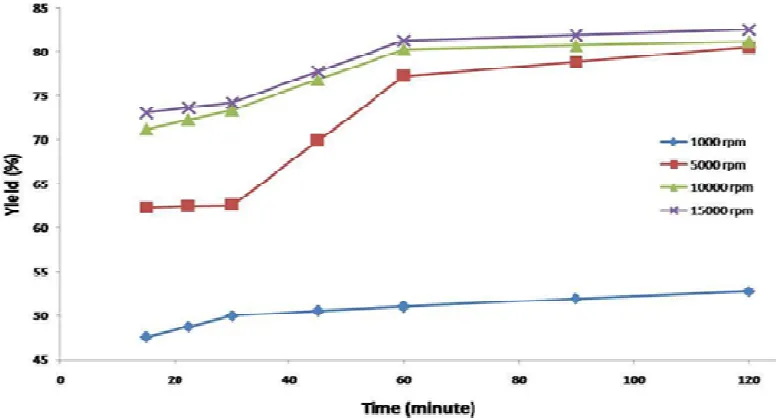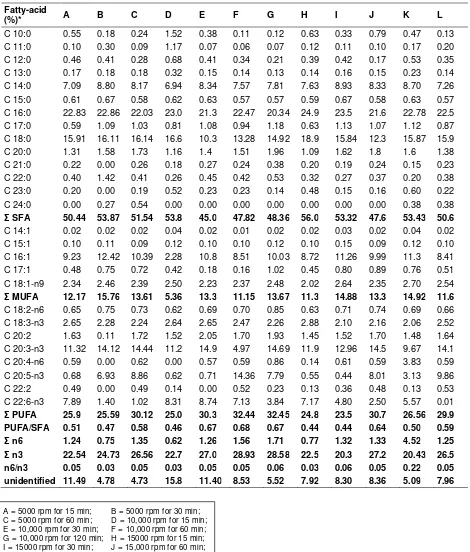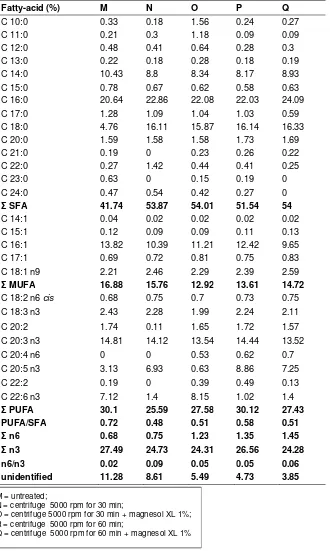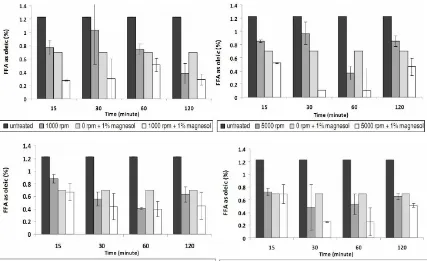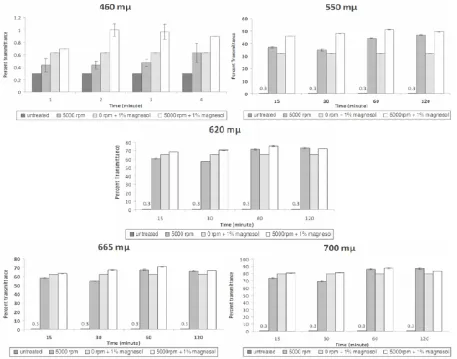Full Length Research Paper
The Use of Passive Filtration for Optimization of
Magnesol XL Function for Improving the Quality of
Sardinella lemuru
Oil
Suseno S.H
1,
2, Tajul A.Y
1* and Wan Nadiah, W.A
11
School of Industrial Technology, Food Technology Division, Universiti Sains Malaysia, 11800 Penang, Malaysia.
2
Department of Fisheries Product Technology, Faculty of Fisheries and Marine Science. Bogor, Indonesia.
Accepted 4 May 2011
Factors important to alkali refining operation of fish oil are optimum soapstock separation to get maximum on removal free fatty acid (FFA) and bleaching. This paper discusses the use of centrifuge and whatman filter paper to get optimum condition magnesol XL for removing polar compound of fish oil alkali refining. The best treatment for soapstocks removal was centrifugation at 15,000 rpm for 2 hours, with yield of neutral fish oil by 82.53%, then for passive filtration using whatman grade no. 54 filter paper could remove soapstocks was 77.63% of alkali fish oil yield. The use of passive filter treatment, optimum conditions to reduce FFA of sardine alkali refining was centrifugation at 5000 rpm for 60 minute, removing 69.92% of FFA. The combination of passive filtration using centrifugation at 5000 rpm for 30 minutes with depth filtration using 1% magnesol XL are the best treatment FFA reduction by 91.05%. At all treatment showed significant (p≤0.05) for Σ SFA, Σ MUFA and Σ PUFA of fatty acid.
Keywords: Sardine fish oil, magnesol XL, passive filtration, active filtration, soapstocks, free fatty acid and fatty acid.
INTRODUCTION
Over the last decades, the growing consumer awareness of good nutrition and a healthy lifestyle has caused an increased interest in the nutritional aspects of food oils and fats. High quality food oils should have a balanced fatty acid (FA) composition and should contain high levels of valuable minor compounds such as vitamins and natural antioxidants. Fish oil is an excellent source of n-3 fatty acids (n-3 FAs), mainly Eicosapentaenoic Acid (EPA) and Docosahexaenoic Acid (DHA). The n-3 FAs are claimed to be essential for normal growth and development and to play an important role in the prevention and treatment of hypertension, cancer, and several inflammatory and autoimmune disorders (Dewailly et al., 2001).
About 20,000 to 30,000 metric tons of crude Lemuru (Sardinella lemuru) fish oil is produced annually a by-product from the processing of fish meal in East Java,
*Corresponding author Email: [email protected] , Tel. +60-164274605 Fax.+60-46573678
Indonesia. Much of the oil in the sardine is found to contain approximately 15–20% lipids and a high concentration of n-3 FA (Khoddami et al., 2009). Now Sardine fish oil is used as an animal feed ingredient in Indonesia. It contains many unsaponifiable compounds therefore, the oil needs further refining to be suitable for use as a healthful food.
Crude edible fats and oils contain variable amounts of glyceride impurities, such as free fatty acids, non-fatty materials generally classified as "gums," and pigments. Most of these impurities are detrimental to the end product quality, hence must be eliminated by a purification process before the finished fats and oils are suitable for human consumption.
by centrifugation. Typically, soapstock will account for 5 to 10% of the crude oil mass, although higher values are possible if the crude oil is "color set" or has a high treatments remove surfactant materials carbonized on the surface as well as precursors of polymers formed from oils, and reduces the frequency of cleanups and the amount of caustic cleaning compounds needed in this context. The active treatments are generally adsorbents powders such as diatomaceous earth, magnesium and calcium silicates, rhyolite and pumice materials, zeolites, and alumina. Passive treatments are filter aids as materials or systems, and perform a polishing function to remove solid particles, microemulsified water, and components such as free radical oxygen, copper or iron, that accelerate the oxidative reaction (Bhattacharya et al., 2008). Some synthetic adsorbents studied individually or combined with natural adsorbents for their ability to effectively reduce one or more components such as FFA and colour (pigment) demonstrated magnesium oxide to decrease FFA, while all other treatments effectively reduced only the colour (Mancini-Filho et al., 1986).
Alkali refining using caustic soda is a conventional method in refining fish oil, but this method is still relevant to produce refined fish oil in Indonesia due to its simple process and available manufacturing facilities. At present, the product is used solely for feed. The optimization of sardine oil refining to obtain a product of good quality according to IFOS is paramount.
This paper discusses the best treatment of passive and depth filter for maximum removal of FFA. Until now study about the effect separation of soapstocks for optimum of removal FFA using magnesol XL is still limited. Outcome of the research are improving of the refining method and quality of fish oil..
MATERIALS AND METHODS
Materials
Fish oil was obtained from a fish-meal plant in East Java, Indonesia which produces the oil from Lemuru fish meal by-product. The filter aids were used is magnesol XL (hydrous, white, amorphous and odourless) obtained from Magnesol Product Division, Reagent Chemical and Research, Inc., Houston, Texas, 77 016, USA. Passive filtration used Whatman filter paper Grade no1, no.3, no. 4, no.41 no. 54 and centrifugation was carried out using KUBOTA Compact High Speed Refrigerated Centrifuge 6500.
Methods
Sample treatments
Briefly of research: The alkali-refined sardine oil was centrifuged at various speeds (1000, 5000, 10000, 15000 and 18000 rpm) with a length of time set at was 15, 30, 60 and 120 minute respectively. The purpose of treatment was to separate soapstock from fish oil. Percentage (%) of fish oil yield were determined with measurement of fish oil filtrate (removing of the soapstock). Then the passive filter also used the Filter aid was Whatman filer paper grade no.1, 3, 4, 41 and 54. After passive filter (centrifuge and whatman filter) treatment, all fish oil sample were mixed with magnesol XL adsorbent 1% for 20 minute at 25°C. Then, it was removed by centrifugation at 10,000 rpm for 30 minute. The physicochemical properties of the fish oil samples were analyzed before and after treatment with magnesol XL.
Physico properties of the fish oils
Percent Transmission
The method used was patterned after the AOCS Spectrophotometric Method (Tentative Method Ce 13c-50), whereby the percent transmission of the oil was measured directly, using 1 cm cells and carbon tetrachloride as the reference standard (Gauglitz and Gruger, 1965).
Colour
A Lovibond tintometer was used to measure the colour of the oil samples under investigation. The yellow glass filter was fixed at 35 and the intensity of the red glass colour was measured (Nielsen, 1998).
CIE-L*a*b* color measurement.
menhaden oil (Omega Protein Inc., Reedville, VA) was oil viscosity using an Ostwald viscometer (Joslyn, 1996). Density
The enables of fluid oil was measured with using pyknometer or specific gravity bottle (Hodgman and Lange, 1924). prepared saturated KI (potassium iodide) solution was added and the mixture vortexed for exactly 1 min. Distilled water (30 mL) and stock solution (0.5 mL, starch 1%) were added and the liberated iodine was titrated with sodium thiosulfate (0.1 mol L-1) (AOCS, 1998).
Free fatty acid (FFA) determination by titration
The experimental procedure described in AOCS method Ca 5a-40 was followed to determine the percent FFA in each sample. Briefly, oil was weighed into a flask followed by neutralized 95% ethyl alcohol and phenolphthalein indicator. The mixture was then titrated against sodium hydroxide solution until a permanent pink color persisted for at least 30 s. Percentage of FFA by weight was calculated on either an oleic, palmitic, or lauric acid basis, depending on the type of oil being analyzed (AOCS, 1998). Each sample was titrated in triplicate.
Evaluation of efficiency of adsorption process
The passive and depth filtration and also their combinations were evaluated for their performance in improving oil quality. This was determined by calculating percentage improvement as Percentage Improvement (%
The percentage improvement of adsorbents for both passive and depth filtration was calculated and reported as average percentage improvement (API).
Statistical analysis
The experiment was run in triplicate with a 2x3 factorial in completely randomized design (CRD). The data were subjected to analysis of variance (ANOVA). The differences among the treatments were determined using Duncan's multiple range test. present to form soaps. The soaps together with hydrated phosphatides, gums and prooxidant metals are separated from the refined oil as the heavy phase discharge from the refining centrifuge and is known as soapstock. In this research, the separation of soapstock was carried out using centrifuge and whatman filter paper. A centrifuge was then used to separate the aqueous phase containing soaps from the liquid oil phase. The yield of neutral oil after separation from soap stock is shown in Figure 1.
The best treatment for soapstocks removal was centrifugation at 15,000 rpm for 2 hours It showed significant different with other treatment. Different speed and time treatment were significant (P≤0.05) for soap stocks separation. There was correlation between speed (rpm) and time (minute). At speed treatment, the yield (%) of fish oil filtrate was depend on duration time. The percentage (%) yield of neutral lipid with using centrifuge treatment with speed 1000, 5000, 10,000, 15,000 and 18,000 rpm at time 15 to 120 minute separation of soapstock were 47-52, 62-77, 71.2-81.19, 73.1-82.53 and 77.94-78.53%, respectively. The percentage (%) yield of neutral lipid with using whatman grade no. 54, 41, 4, 3 and 1 filter paper were 77.63, 69.77, 65.53, 65.17 and 64.55% respectively. Different size of whatman filter paper was significant (P≤0.05) for yield (percentage). Efficient separation of the stock from the neutralization is usually accomplished with centrifugal separator (O’Briend, 1998).
The Effect of Passive Filtration on Free fatty Acid (FFA) content
Figure 1 Yield of Neutral Oil After Separation from Soap Stock
pigments, sterols, meal, oxidized materials, waxes, moisture and dirt. Most of these impurities are detrimental to finished product color, flavor, foaming and smoking stability; hence, must be separated from the neutral oil by a purification step.
This research used the centrifuge and whatman filter paper treatment as passive filter and magnesol XL as active depth filter for removing free fatty acid and oxidative compound. Table 2 shows FFA value after passive and active filtration treatment. The FFA content of untreated fish oil was 0.85 mev/kg as control, then after passive filtration treatment (with using centrifuge at 1000 rpm for 120 minute and 5000 rpm for 60 minute) can remove 55,29% and 56.47% of FFA respectively. They were significant (P≤0.05) at untreated and all centrifuge treatment except at 10000 rpm for 30 minute, 15000 for 30 minute and 15000 for 60 minute. The treatment caused dedecresing of FFA content. It will separate free fatty acid as impurities from neutral oil. Different of the centrifuge treatment (speed and time) can effect FFA content. The treatment also caused minor constituent such as tocopherol as natural antioxidant in neutral oil examined be removed by the treatment so that increased FFA content. On the other hand, tocopherols are important minor constituents of vegetable oils. They perform the important function as natural antioxidant protectors of oil keeping quality by retarding the development of .rancidity (Roy, 1978).
The separation of the FFA using whatman filter is shown in Table 2. The result of the research was different significant with centrifuge treatment. The use of whatman filter grade no 1, 3, 4 and 54 showed significantly increased AV content. However, the oxidative stability of
neutral oils may also be influenced by minor constituents that are naturally present or through contamination (oxygen, temperature and light) during the refining processing.
Table 2 also showed that FFA value after centrifugation was relatively high, hence adsorbent treatment with added 1% magnesol was carried out. The combination of passive filter using centrifuge treatment with speed 5000 rpm for 30 minute and depth filtration using 1% magnesol were the best treatment for removal of FFA. The FFA removal was 85.88%. It is significant (P≤0.05) with untreated, centrifuge 1000 rpm for 15 minute, centrifuge 5000 rpm for 60 minute, centrifuge 15000 rpm for 30 minute, centrifuge 15000 rpm for 30 minute and 60 minute, and centrifuge 18000 rpm for 15 minute. Then, Figure 2 shows acid value before and after magnesol 1% treatment.
Magnesol 3% is able to reduce FFA to 0.04% (Wang and Johnson, 2001). Its major component is magnesium silicate. It reduced residual phosphorus contents to negligible levels. This material also adsorbed primary and secondary oil oxidation products. The combination of HB (Hubersorb) 600 and Magnesol reduced FFA and TPC (Total Polar Compound) by 90.8-93.7% and 6.0-17.8% respectively. They improved oil stability by 23.4-24.7% The recovery of used frying oils with various 150°C (Lin et al., 1998).
Table 1. Profile Fatty Acid of Sardine Oil of Centrifuge Treatment
Fatty-acid
(%)* A B C D E F G H I J K L
C 10:0 0.55 0.18 0.24 1.52 0.38 0.11 0.12 0.63 0.33 0.79 0.47 0.13 C 11:0 0.10 0.30 0.09 1.17 0.07 0.06 0.07 0.12 0.11 0.10 0.17 0.20 C 12:0 0.46 0.41 0.28 0.68 0.41 0.34 0.21 0.39 0.42 0.17 0.53 0.35 C 13:0 0.17 0.18 0.18 0.32 0.15 0.14 0.13 0.14 0.16 0.15 0.23 0.14 C 14:0 7.09 8.80 8.17 6.94 8.34 7.57 7.81 7.63 8.93 8.33 8.70 7.26 C 15:0 0.61 0.67 0.58 0.62 0.63 0.57 0.57 0.59 0.67 0.58 0.63 0.57 C 16:0 22.83 22.86 22.03 23.0 21.3 22.47 20.34 24.9 23.5 21.6 22.78 22.5 C 17:0 0.59 1.09 1.03 0.81 1.08 0.94 1.18 0.63 1.13 1.07 1.12 0.87 C 18:0 15.91 16.11 16.14 16.6 10.3 13.28 14.92 18.9 15.84 12.3 15.87 15.9 C 20:0 1.31 1.58 1.73 1.16 1.4 1.51 1.96 1.09 1.62 1.8 1.6 1.38 C 21:0 0.22 0.00 0.26 0.18 0.27 0.24 0.38 0.20 0.19 0.24 0.15 0.23 C 22:0 0.40 1.42 0.41 0.26 0.45 0.42 0.53 0.32 0.27 0.37 0.20 0.38 C 23:0 0.20 0.00 0.19 0.52 0.23 0.23 0.14 0.48 0.15 0.16 0.60 0.22 C 24:0 0.00 0.27 0.54 0.00 0.00 0.00 0.00 0.00 0.00 0.00 0.38 0.38 Σ SFA 50.44 53.87 51.54 53.8 45.0 47.82 48.36 56.0 53.32 47.6 53.43 50.6 C 14:1 0.02 0.02 0.02 0.04 0.02 0.01 0.02 0.02 0.03 0.02 0.04 0.02 C 15:1 0.10 0.11 0.09 0.12 0.10 0.10 0.12 0.10 0.15 0.09 0.12 0.10 C 16:1 9.23 12.42 10.39 2.28 10.8 8.51 10.03 8.72 11.26 9.99 11.3 8.41 C 17:1 0.48 0.75 0.72 0.42 0.18 0.16 1.02 0.45 0.80 0.89 0.76 0.51 C 18:1-n9 2.34 2.46 2.39 2.50 2.23 2.37 2.48 2.02 2.64 2.35 2.70 2.54 Σ MUFA 12.17 15.76 13.61 5.36 13.3 11.15 13.67 11.3 14.88 13.3 14.92 11.6 C 18:2-n6 0.65 0.75 0.73 0.62 0.69 0.70 0.85 0.63 0.71 0.74 0.69 0.66 C 18:3-n3 2.65 2.28 2.24 2.64 2.65 2.47 2.26 2.88 2.10 2.16 2.06 2.52 C 20:2 1.63 0.11 1.72 1.52 2.05 1.70 1.93 1.45 1.52 1.70 1.48 1.64 C 20:3-n3 11.32 14.12 14.44 11.2 14.9 4.97 14.69 11.9 12.96 14.5 9.67 14.1 C 20:4-n6 0.59 0.00 0.62 0.00 0.57 0.59 0.86 0.14 0.61 0.59 3.83 0.59 C 20:5-n3 0.68 6.93 8.86 0.62 0.71 14.36 7.79 0.55 0.44 8.01 3.13 9.86 C 22:2 0.49 0.00 0.49 0.14 0.00 0.52 0.23 0.13 0.36 0.48 0.13 0.53 C 22:6-n3 7.89 1.40 1.02 8.31 8.74 7.13 3.84 7.17 4.80 2.50 5.57 0.01 Σ PUFA 25.9 25.59 30.12 25.0 30.3 32.44 32.45 24.8 23.5 30.7 26.56 29.9 PUFA/SFA 0.51 0.47 0.58 0.46 0.67 0.68 0.67 0.44 0.44 0.64 0.50 0.59 Σ n6 1.24 0.75 1.35 0.62 1.26 1.56 1.71 0.77 1.32 1.33 4.52 1.25 Σ n3 22.54 24.73 26.56 22.7 27.0 28.93 28.58 22.5 20.3 27.2 20.43 26.5 n6/n3 0.05 0.03 0.05 0.03 0.05 0.05 0.06 0.03 0.06 0.05 0.22 0.05 unidentified 11.49 4.78 4.73 15.8 11.40 8.53 5.52 7.92 8.30 8.36 5.09 7.96
A = 5000 rpm for 15 min; B = 5000 rpm for 30 min; C = 5000 rpm for 60 min; D = 10,000 rpm for 15 min; E = 10,000 rpm for 30 min; F = 10,000 rpm for 60 min; G = 10,000 rpm for 120 min; H = 15000 rpm for 15 min; I = 15000 rpm for 30 min; J = 15,000 rpm for 60 min; K = 15,000 rpm for 120 min; L = 18,000 rpm for 15 min.
which correspond to the adsorption of free fatty acids and pigment, respectively (Yates and Caldwell, 1992). Consisted of magnesium silicate, the magnesol played an
Table 2. Profile Fatty Acid of Sardine Oil of Centrifuge Treatment and Combination Treatment (1% Magnesol XL)
Fatty-acid (%) M N O P Q
C 10:0 0.33 0.18 1.56 0.24 0.27
C 11:0 0.21 0.3 1.18 0.09 0.09
C 12:0 0.48 0.41 0.64 0.28 0.3
C 13:0 0.22 0.18 0.28 0.18 0.19
C 14:0 10.43 8.8 8.34 8.17 8.93
C 15:0 0.78 0.67 0.62 0.58 0.63
C 16:0 20.64 22.86 22.08 22.03 24.09
C 17:0 1.28 1.09 1.04 1.03 0.59
C 18:0 4.76 16.11 15.87 16.14 16.33
C 20:0 1.59 1.58 1.58 1.73 1.69
C 21:0 0.19 0 0.23 0.26 0.22
C 22:0 0.27 1.42 0.44 0.41 0.25
C 23:0 0.63 0 0.15 0.19 0
C 24:0 0.47 0.54 0.42 0.27 0
Σ SFA 41.74 53.87 54.01 51.54 54
C 14:1 0.04 0.02 0.02 0.02 0.02
C 15:1 0.12 0.09 0.09 0.11 0.13
C 16:1 13.82 10.39 11.21 12.42 9.65
C 17:1 0.69 0.72 0.81 0.75 0.83
C 18:1 n9 2.21 2.46 2.29 2.39 2.59
Σ MUFA 16.88 15.76 12.92 13.61 14.72
C 18:2 n6 cis 0.68 0.75 0.7 0.73 0.75
C 18:3 n3 2.43 2.28 1.99 2.24 2.11
C 20:2 1.74 0.11 1.65 1.72 1.57
C 20:3 n3 14.81 14.12 13.54 14.44 13.52
C 20:4 n6 0 0 0.53 0.62 0.7
C 20:5 n3 3.13 6.93 0.63 8.86 7.25
C 22:2 0.19 0 0.39 0.49 0.13
C 22:6 n3 7.12 1.4 8.15 1.02 1.4
Σ PUFA 30.1 25.59 27.58 30.12 27.43 PUFA/SFA 0.72 0.48 0.51 0.58 0.51
Σ n6 0.68 0.75 1.23 1.35 1.45
Σ n3 27.49 24.73 24.31 26.56 24.28
n6/n3 0.02 0.09 0.05 0.05 0.06
unidentified 11.28 8.61 5.49 4.73 3.85
M = untreated;
N = centrifuge 5000 rpm for 30 min;
O = centrifuge 5000 rpm for 30 min + magnesol XL 1%; R = centrifuge 5000 rpm for 60 min;
Q = centrifuge 5000 rpm for 60 min + magnesol XL 1%
surface area and is widely used as an analytical and industrial adsorbent (Munsom et al., 1996). The study of surface area indicated that diatomaceous earth has very
Figure 2. FFA Value After Passive and Active Filtration
adsorption of FFA and color producing materials, indicating the importance of surface area, particle size and porosity of filter aid in neutral oil recovery technology. The amount of adsorption depends on the polarity, surface active sites, surface area, porosity, particle size, pH and moisture content (Zhu et al., 1994).
Spectrophotometer
Bleaching of alkali-refined oils removes entrained soaps and reduces color bodies in the oil; it is more appropriately referred to as adsorption treatment. The percent transmittance of the bleached oil at particular wavelengths is given in Table 3. The better treatment easily remove the pigments have been showed at 620-700 mµ range of the spectra. The result of spectrophotometer show that at 460 mµ, All treatment was not significant different to compared the untreated whatman filter grade no. 3 and 54 filter paper and standard fish oil. At centrifuge 1000 rpm for 15-120 minute were not significant with untreated in 550 mµ, 620 mµ and 665 mµ. At 620 mµ and 700 mµ, all treatment were significant with standard fish oil. At treatment with using centrifuge 10000 rpm for 30 minute, centrifuge 18000 rpm for 30 minute and whatman grade no.54 filter paper were not significant with standard fish oil. Then at centrifuge 5000, 10000, 15000 rpm for 60 minute with 1% magnesol also showed insignificant with standard fish oil.
Fatty acid profiles
Table 3 showed that fat content of a range of the centrifuge treatment oil consisted of Σ SFA ( 45.00-56.00), Σ MUFA (5.36 -15.76), Σ PUFA (23.5-32.45), PUFA/SFA (0.44-0.68), Σ n6 (0.75-4.52) and Σ n3 (20.3 – 28.93). The fatty acid profile generally exhibits a dominance of the two classes, SFAs and PUFAs (Table 3). Among them, those occurring SFA in the highest proportions were stearic acid (C16:0) (21.6 – 24.9), then MUFA was C 16: 1 (2.28 – 12.42). For PUFA was C 20: 3 n3 (9.67-14.97). Table 3 showed significant (p≤0.05) for Σ
SFA, Σ MUFA and Σ PUFA at all treatment, then at centrifuge on the same of speed with different time effect increasing the composition of omega-3. The proportions of PUFAs-n3 were higher than those of PUFAs-n6. The UK Department of Health recommends an ideal ratio of n6/n3 of 4.0 at maximum (HMSO, 1994).Values higher than the maximum value are harmful to health and may promote cardiovascular diseases (Moreira et al., 2001). In this study, the range of the ratio of n6/n3 was 0.03-0.22.
Table 3. Profile Fatty Acid With Using Whatman Filter and Magnesol XL 1%
Fatty-acid(%)* 1 2 3 4 5 6 7 8 9 10
C 10:0 1.45 0.99 2.37 2.02 2.15 0.59 0.31 1.37 0.55 0.52 C 11:0 0.28 0.24 1.83 1.66 1.1 0.35 0.1 1.05 0.11 0.31 C 12:0 1.11 0.48 1.12 1.08 0.69 0.12 0.41 0.69 0.56 0.1
C 13:0 0.32 0.19 0.6 0.25 0.36 0.18 0.13 0.19 0.17 0.13 C 14:0 8.32 7.43 6.09 7.93 7.82 8.92 6.77 8.17 7.16 8.49 C 15:0 0.73 0.55 0.08 0.66 0.86 0.66 0.56 0.64 0.58 0.65 C 16:0 25.11 21.89 22.29 20.87 23.76 20.81 23.15 20.98 22.99 21.18 C 17:0 0.91 0.89 0.59 1.01 0.94 1.11 0.86 1.01 0.9 1.08
C 18:0 17.23 13.42 17.41 9.49 16.61 8.94 17.09 9.97 17.39 9.33 C 20:0 1.04 1.47 0.9 0.96 1.09 0.29 1.2 1.25 1.22 1.12 C 21:0 0.12 0.24 0.21 0.28 0.13 0.29 0.23 0.26 0.18 0.26 C 22:0 0.16 0.4 0.28 0.39 0.19 0.44 0.35 0.41 0.27 0.43
C 23:0 0.49 0.16 0.57 0.26 0.45 0.22 0.52 0.21 0.55 0.19
C 24:0 0.32 0.74 0.71 0 0.32 0.37 0.47 0.4 0.39 0
Σ-SFA 57.59 49.09 55.05 46.86 56.47 43.29 52.15 46.6 53.02 43.79 C 14:1 0.04 0.01 0.55 0.05 0.05 0.02 0.02 0.03 0.03 0.02 C 15:1 0.14 0.09 0.14 0.17 0.25 0.1 0.11 0.12 0.1 0.1
C 16:1 1.64 1.8 8.85 8.67 10.55 11.07 9.38 8.56 10.82 10.35 C 17:1 0.38 0.59 0.3 9.91 0.48 0.71 0.49 0.65 0.38 0.66 C 18:1 n9 2.43 2.32 2.49 1.8 2.42 2.11 2.59 2.14 2.69 1.76
Σ-MUFA 4.63 4.81 12.33 20.6 13.75 14.01 12.59 11.5 14.02 12.89 C 18:2 n6 3.02 0.67 0.64 0.73 0.58 0.71 0.66 2.14 0.71 0.72 C 18:3 n3 2.52 2.67 2.96 3.07 2.53 2.74 2.85 2.71 2.71 0.58 C 20:2 1.31 1.69 1.55 2.09 1.29 2.22 1.62 1.98 1.59 2.22 C 20:3 n3 11.51 14.07 13.09 13.63 11.43 14.87 11.01 14.2 10.94 14.86
C 20:4 n6 0.00 0.49 0.00 0.52 0.00 0.56 2.81 0.54 3.06 0.54 C 20:5 n3 2.28 9.21 4.65 0.81 6.92 0.47 0.71 0.36 0.61 0.84 C 22:2 0.18 0.43 0.23 0.56 0.21 0.64 0.21 0.58 0.20 0.64 C 22:6-n3 4.51 0.01 3.06 8.29 0.01 10.29 8.94 9.77 8.35 10.28
Σ PUFA 25.33 29.24 26.18 29.7 22.97 32.5 28.81 32.28 28.17 30.68 PUFA/SFA 0.44 0.596 0.476 0.634 0.407 0.751 0.552 0.6927 0.531 0.701 Σ n6 3.02 1.16 0.64 1.25 0.58 1.27 3.47 2.68 3.77 1.26 Σ n3 20.82 17.24 23.76 25.51 20.89 28.46 23.51 27.22 22.61 26.26 n6/n3 0.14 0.07 0.03 0.05 0.03 0.04 0.15 0.09 0.17 0.05 Unidentified 12.45 16.86 6.44 2.84 6.81 10.20 6.45 9.62 4.79 12.64
1 = whatman filter 01;
2 = whatman filter 01 +magnesol 1%; 3 = whatman filter 03;
4 = whatman filter 03 + magnesol 1%; 5 = whatman filter 04;
6 = whatman filter 04 +magnesol 1%; 7 =whatman filter 41;
8 = whatman filter 41 +magnesol 1%; 9 = whatman filter 54;
10= whatman filter 54 + magnesol 1%
rpm for 60 minute + magnesol 1%, 5000 rpm for 30 minute and 5000 rpm for 30 minute + magnesol 1%
Figure 3. Acid Value Before and After Magnesol XL 1% Treatment
Figure 4. Percentage Improvement (%PI) Before and After Magnesol 1% Treatment
treatment caused decreasing of unidentified percentage of fatty acid. Percentage (%) fatty acid composition of MUFA was 16.88, 15.76, 12.92, 13.61 and 14.72, respectively. Then, PUFA was 30.1, 25.59, 27.58, 30.12
Figure 5. Percent Transmittance of The Bleached Oil at Particular Wavelengths
Adsorbent treatment effected to decrease Σ n3 on untreated and centrifuge treatment.
Table 5 show that fat content of a range of the passive filter using whatman filter paper treatment oil consisted of
Σ SFA (43.29-57.59), Σ MUFA (4.63-20.6), Σ PUFA (25.33-32.5), PUFA/SFA (0.44-0.69), Σ n6 (0.58–3.77), Σ
n3 (17.24–28.46) and n6/n3 (0.03–0.17). At all treatment showed significant (p≤0.05) for Σ SFA, Σ MUFA and Σ
PUFA. After treatment with using adsorbent Σ SFA was decrease but Σ PUFA was increasing. In general, percentage for Σ n3 was increasing after adsorbent treatment. The fatty acid profile generally exhibits a dominance of the two classes, SFAs and PUFAs (Table 3).
CONCLUSION
Overall, the data shown that the magnesol XL studied possessed useful scavenging properties, i.e. it removed
the oxidation product from fish oil. At centrifuge treatment with speed 15,000 rpm for 2 hours is the best treatment for separation of soapstock. Then the separation of soap stock using whatment filter is the best grade no. 54. At passive filter treatment, optimum conditions for reduce FFA of sardine alkali refining were centrifuge 1000 rpm for 120 minute and 5000 rpm for 60 minute could removal of FFA were 55.29% and 56.47% respectively. Then combination passive filter (centrifuge 5000 rpm for 30 minute) and 1% magnesol XL could reduce FFA by 85.88%. It is the best treatment for removal of FFA. At all treatment showed significant (p≤0.05) for Σ SFA, Σ MUFA and Σ PUFA of fatty acid.
ACKNOWLEDGEMENTS
(1001/PTEKIND/842023) and the research
facilities made available by the by Dean of the School of Industrial Technology, USM, Penang.
REFERENCES
AOCS (1998). Free Fatty Acids In: Official Methods and Recommended Practices of the American Oil Chemists Society. Vol 5a. 5th ed. AOCS Press. Champaign. p 40.
Bhattacharya BA, Sajilata MG, Tiwari SR, Singhal RS (2008). Regeneration of Thermally Polymerized Frying Oils with Adsorbents. Food Chem. 110: 562–570.
Dewailly E, Blanchet C, Lemieux S, Sauve L, Gingras S, Ayotte P, and Holub BJ (2001). n-3 Fatty acids and Cardiovascular Disease Risk Factors Among the Inuit of Nunavik. J.Am.Clin. Nut. 74: 464–473. Dumont M-J, Narine SS (2007). Soapstock and Deodorizer Distillates
from North American Vegetable Oils: Review on Their Characterization, Extraction and Utilization. J. Food Research International. 40: 957–974.
Gauglitz JR, Gruger JR. (1965). Bleaching and Molecular Distillation of Menhaden Oil. J. Am. Oil Chem. Soc. vol.42: 561-563.
HMSO UK (1994). Nutritional Aspects of Cardiovascular Disease (Report on Health and Social Subjects No. 46. London, HMSO. Hodgman CD, Lange NA (1924). Handbook of Chemistry and Physics.
Cleveland: Chemical Rubber Co, pp. 312-313.
Joslyn MA (1996). Methods in Food Analysis. Academic Press, New York. pp: 49-61
Khoddami A, Ariffin A, Bakar J, Ghazali (2009). Fatty Acid Profile of
the Oil Extracted from Fish Waste (Head, Intestine and Liver) (Sardinella lemuru). World Appl. Scien. Vol. 7 (1): 127-131.
Lin S, Akoh' CC, Reynolds AE (1998). The Recovery Of Used Frying Oils With Various Adsorbents. J. Food Lipids 5: 1-16.
Mancini-Filho J, Smith LM, Creveling RK, Al-Shaikh, HF (1986). Effects of Selected Chemical Treatments on Quality of Fats Used for Deep-frying. J. Am. Oil Chem. Soc. 63: 1564–1567.
Moreira AB, Visentainer JV, de Souza NE, Matsushita M (2001). Fatty Acids Profile and Cholesterol Contents of Three Brazilian Brycon Freshwater Fishes. J. Food Compos and Anal 14: 565–574.
Munson BL, Bertram JD, Caldwell (1996). Treatment of Cooking Oils and Fats with Magnesium Silicate and Alkali Materials. U. S. Patent 5597600.
Nielsen SS (1998). Food Analysis, 2nd edition. Aspen Inc., Gaithersburg, Maryland, pp. 222-223.
O’Briend RD (1998). Fats and Oils Formulating and Processing for Applications: Technomic Publishing Co., Lancaster, PA., pp. 1-4, 47-54, 129-131, 168-175, 182-183, 251-253, 258-260, 264-266, 483, 525, 652-653.
Roy AC (1978). Refining and Degumming Systems for Edible Fats, J. Am. Oil Chem. Soc. Vol 55.
Wang T, Johnson LA (2001). Natural Refining of Extruded-Expelled Soybean Oils Having Various Fatty Acid Compositions, J. Am. Oil Chem. Soc. 78, no. 5.
Yates RA, Caldwell JD (1992). Adsorptive Capacity of Active Filter Aids for Used Cooking Oil, J. Am. Oil Chem. Soc. 69: 894-897.
Zhu ZY, Yates RA, Caldwell JD (1994). The Determination of Active Filter Aid Adsorption Sites by Temperature-Programmed Desorption. J. Am. Oil Chem. Soc. 71: 189-194.
